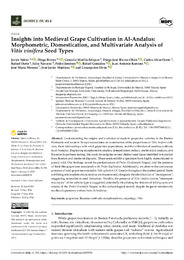Please use this identifier to cite or link to this item:
https://hdl.handle.net/11000/38299Full metadata record
| DC Field | Value | Language |
|---|---|---|
| dc.contributor.author | Valera, Javier | - |
| dc.contributor.author | Rivera, Diego | - |
| dc.contributor.author | Matilla Séiquer, Gonzalo | - |
| dc.contributor.author | Rivera Obón, Diego José | - |
| dc.contributor.author | Alvar Ocete, Carlos | - |
| dc.contributor.author | Ocete, Rafael | - |
| dc.contributor.author | Navarro, Julio | - |
| dc.contributor.author | Jiménez, Pedro | - |
| dc.contributor.author | González, Rafael | - |
| dc.contributor.author | Ramírez, Juan Antonio | - |
| dc.contributor.author | Moreno, José María | - |
| dc.contributor.author | Martínez, José Javier | - |
| dc.contributor.author | Obón, Concepción | - |
| dc.contributor.other | Departamentos de la UMH::Biología Aplicada | es_ES |
| dc.date.accessioned | 2025-11-19T12:33:16Z | - |
| dc.date.available | 2025-11-19T12:33:16Z | - |
| dc.date.created | 2024-05 | - |
| dc.identifier.citation | Horticulturae 2024, 10, 530. | es_ES |
| dc.identifier.issn | 2311-7524 | - |
| dc.identifier.uri | https://hdl.handle.net/11000/38299 | - |
| dc.description.abstract | Understanding the origins and evolution of modern grapevine varieties in the Iberian Peninsula and western Europe necessitates an examination of the proportions of Vitis vinifera cultivars, their relationships with wild grapevine populations, and the utilization of seedless cultivars in al-Andalus. Employing morphometric studies, domestication indices, multivariate analysis, and Bayesian hypothesis testing, this study investigates several distinct seed types identified in materials from Roman and medieval deposits. These seeds exhibit a spectrum from highly domesticated to purely wild. Our findings reveal the predominance of Proles Occidentalis Negrul, and the presence of feral-like grapevines associated with Proles Euphratica. Additionally, we observe the continuous presence of wild grapevines related to Vitis sylvestris CC Gmelin throughout the studied period. Seeds exhibiting intermediate characteristics are documented, alongside the identification of “stenosperms”, suggesting anomalies in seed formation. Notably, the presence of Vitis vinifera raisins “stenospermocarpics” of the sultana type is suggested, potentially elucidating the absence of table grapes and raisins of the Proles Orientalis Negrul in the archaeological record, despite frequent mentions by medieval agronomy writers from al-Andalus. | es_ES |
| dc.format | application/pdf | es_ES |
| dc.format.extent | 24 | es_ES |
| dc.language.iso | eng | es_ES |
| dc.publisher | MDPI | es_ES |
| dc.rights | info:eu-repo/semantics/openAccess | es_ES |
| dc.rights.uri | http://creativecommons.org/licenses/by-nc-nd/4.0/ | * |
| dc.subject | grapevine | es_ES |
| dc.subject | Bayesian methods | es_ES |
| dc.subject | morphometrics | es_ES |
| dc.subject | carpology | es_ES |
| dc.subject | Vitis | es_ES |
| dc.title | Insights into Medieval Grape Cultivation in Al-Andalus: Morphometric, Domestication, and Multivariate Analysis of Vitis vinifera Seed Types | es_ES |
| dc.type | info:eu-repo/semantics/article | es_ES |
| dc.relation.publisherversion | https://doi.org/10.3390/horticulturae10050530 | es_ES |

View/Open:
Valera 2024 Medieval horticulturae-10-00530-v3r.pdf
1,37 MB
Adobe PDF
Share:
.png)
